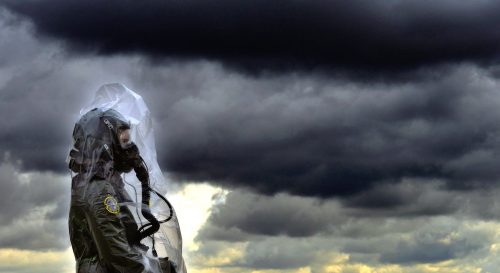Editorial note: In 2004, Susan Dubrofsky, co-editor of Montréal Serai, published 11 Steps. She has now revisited the same piece twelve years later, with the following preface.
It has been 12 years since I wrote 11 Steps. I wrote this piece after I had found, tucked among my books, a small red booklet entitled 11 Steps to Survival, published by the Canada Emergency Measures Organization and reissued in the 1980s. My intention was to add a vintage texture to my story, as this booklet had directions and pictures that felt like they came right out of the 1950s. The booklet also contained erroneous and outdated information.
The immediate ‘threat’ and fear of a nuclear Armageddon seemed to subside with the demise of the Cold War in 1991 when the Soviet Union ceased to exist. The idea of a nuclear bomb dropping on any city was pushed into the dusty corners of our reality. A nuclear weapon of today compared with those of Nagasaki and Hiroshima, which had killed an estimated combined total of 210,000 people, would be 16 times more powerful and would kill up to 5.5 million persons.
Using the current information from Wikipedia, I have roughly added up the nuclear accidents globally since 1991 (which excludes the disasters in Three Mile Island and Chernobyl) that have occurred in countries like Canada, France, India and others. They total around 60 mishaps and include various types of disasters such as leaking storage tanks, contaminated water supplies, partial core meltdowns and gas explosions. These incidents are not the dropping of nuclear bombs, but the consequences are attributable to a continuance of being in a nuclear age.
Most discussions about nuclear weapons focus on the Middle East and in particular Iran, and yet there are over 15,000 nuclear weapons worldwide. So can one assume that the prospect of a nuclear attack or exchange could erupt anywhere? Most experts, scientists and analysts of weapons of mass destructions and their potential consequences see the need to recognize that a new Cold War has arisen and we cannot sweep that to the sidelines.
I have made a few minor changes to ‘update’ the piece, but since that time, both cat and boyfriend have disappeared and I do not believe I could race down the stairs as fast as I could then.
11 Steps is a comment on the fogginess in the minds of our government as to what human chaos would really unfold if a nuclear disaster occurred and, according to their booklet, their inadequate advice on what to do in that event. There is a chasm between the superstructure and us as a people, and between their advice and the reality, which generates a huge fault line that might not be passable.

Credit: Suited Up by Stuart Rankin. Edited USAF image of a CBRN (chemical, biological, radiological, and nuclear) training exercise. Taken from flickr under creative commons license: Attribution, NonCommercial.
11 Steps
11 Steps to Survival is the title of a slim red volume printed by the Emergency Planning Department of the Canadian government in 1981. The first line reads: We live in a nuclear age. Having survived the ice age, the age of enlightenment and the age of barium enemas, could we survive the nuclear age? I continue reading. This is a survival guide for you and your family. Read it with care as it could greatly increase your chances of survival. I remember sitting in the dental chair, looking out over the city, having a root canal. As my dentist tinkered with his drill, my mouth was stretched wide open, a forced grimace under the plastic web. I anxiously asked him, “Wha if a nucrear bom dwopped now? Whae I am in thessh chair?” He wisely but unreassuringly said, “Would it matter?”
The first of the 11 steps is Know the effects of nuclear explosion. I stare at my boyfriend across my cup of coffee reheated by microwaves, through the smoke of my cigarette, and ask him, “Do you think we’ll survive if a one-megaton hydrogen bomb is dropped in downtown Montreal?” As he responds, giving details of the size of the Hiroshima and Nagasaki bombs, that they were much smaller and that the size of a bomb dropped depends on how much weight the jet can carry and on the pilot skills, I see a simple diagram in the red book showing the distance the heat and blast travels. From the epicentre of the bomb out to 10 kilometres is total annihilation. Montreal measures roughly 32 by 15 kilometres, and, even if I hear the warning signal, the book tells me I have thirty seconds between the bomb dropping and the blast wave hitting me. Since I live on the third floor, I speculate as to whether I can run down two flights of stairs for shelter in the basement I don’t have, in those thirty seconds. My boyfriend can make it on his own, but what about my cat? I get the metal cat cage from the shed and leave it near the front door in readiness.
The second step is Know the facts about radioactive fallout. Radioactive material from a one-megaton blast would seriously affect an area of 6,000 square kilometres. Montreal is about 480 square kilometres. According to the book, if I reach the phantom basement and have a shield of three feet of water, three inches of lead, five inches of steel, twelve inches of concrete blocks filled with sand, twelve inches of solid brick and two feet of earth all around me, I can stay there safe from radiation for two weeks. And then come out.
Know the warning signal and have a battery-powered radio and spare batteries, is the third step. If there is a warning, I should take protective cover, stay away from windows, lie down, shield my eyes and listen to the radio, although I know I have trouble getting CJAD even on sunny days. And not to use the telephone to call friends or family – but at that moment I would presume they would have some idea about the problem.
Know how to take shelter. The best shelter is the basement I don’t have. Other viable options are under the table or in a ditch.
Step number 5. Have 14 days’ emergency supplies. This includes a car, a road map, folding beds, sleeping bags, folding tables, stools, portable toilet, garbage cans, kerosene stove, electric lamps, an axe, shovel, broom, pocket knife, games, food, clothing, medical supplies, water and all the stuff one would take on a weekend trip to the shack on de lac. I investigate my kitchen cupboards to find some double-scoop raisin bran and, opening the fridge, I find a few ends of cheese, some old pasta, wrinkled carrots and a half-filled jar of jam, horseradish, mustard and relish. I realize I’m dreadfully underequipped. However, I put my Swiss army knife, my cell phone and a bag of cat litter in the cat cage ready by the front door.
The sixth step is Know how to prevent and fight fires. An emergency water supply should be readied in all available pails, bathtubs, washtubs and containers. Fortunately, I have a prime collection of plastic pails. I fill up the bath, the kitchen and bathroom sinks and the pails with water. There is little room to move around in my house now, but I feel secure and well humidified. Moist, even.
Know First Aid and Home Nursing is step number 7. I scan the lengthy list of necessary medical supplies. I have one item that matches the list – a large, nearly empty jar of petroleum jelly. I sigh with relief and read step number 8.
Know emergency cleanliness. This is about garbage and waste products. Secure in the basement I don’t have, surrounded by eight feet of dirt, steel, rock, sand, concrete and wood, if there are no sewage services, I must dig a three-foot pit in the ground through the cement floor. My portable battery-operated jackhammer is ideal for this purpose and I add it to the cat litter and pocketknife in the cat cage.
Step 9. Know how to get rid of radioactive dust or sand. I ask my brother-in-law, only an engineer in the army but the closest to an expert on radioactive fallout that I know, about what to do. He says, after the blast, if you’re outside, you get up off the ground, shake yourself, strip, go back into your home and stay there for two weeks. The book says even if I get stricken with radiation sickness, I am not contagious to others.
Step 10. Know your municipal emergency plan. I call City Hall to ask them what to do if a one-megaton bomb is dropped on us and after thirty minutes of recorded blathering about how my concerns are very important to them, I am connected. A computer voice gives me ten options. I choose the general information number ten because my question doesn’t seem to fit their categories. Then I have another six options. I choose number six. The menu after that has five options. I choose number three. I wait, listening to a piped in radio station and Allstate begins to advertise low rates and special features on life insurance. Another computer voice interrupts to say that all the staff is busy or cannot be reached and that I should try at another time and thank you very much. It then hangs up on me.
The last step is Have a plan for your family and yourself. It is clear my chances of survival are greatest if I practice a workable survival plan based on their recommendations. I haul out my stopwatch, set it to 30 seconds and I prepare myself. I am planning to scream at my boyfriend to get going, then grab all the containers of water, all the canned food, clothing for four seasons, my Scrabble game and crossword puzzles, my portable radio with batteries, the kerosene stove with fuel tanks, the medical supplies and what’s left of the petroleum jelly, the folding beds, tables, stools, my cat in the cat cage with the cat litter, the jackhammer and pocket knife, then run down two flights of stairs for cover to the basement I don’t have. I click the stopwatch on and begin. I screech like a banshee at my boyfriend, who’s watching the Bachelor Season 18. He continues watching as I grab everything listed, put my cat under my arm and race down the hall where I bang my shin on the cat cage, tumble down the inside steps to crash through the front door and down the outside steps to land headfirst on the cement sidewalk. I check my watch and note triumphantly that not only do I have my cell phone still clutched tightly in my fist but that I have managed to get halfway down to the basement I don’t have in 20 seconds. After my head’s been examined, I am convinced, with several dry runs, I will succeed in saving my life before the 30 seconds have expired.










